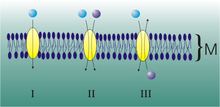Major Facilitator Super Family
| Major Facilitator Super Family | ||
|---|---|---|
| Transporter classification | ||
| TCDB | 2.A.1 | |
| designation | Major Facilitator Super Family | |
| Occurrence | ||
| Parent taxon | Creature | |
The major facilitator superfamily ( MFS ) is a family of membrane proteins . The members of this family make up the largest group of vans . They transport dissolved compounds through cell membranes and are present in all organisms . The transport mode can be both secondary active and passive ( facilitated diffusion ).
Layout and function
The MF superfamily consists of 58 individual families with around 5000 different proteins sequenced to date . This number will continue to increase as organisms continue to be sequenced. The major facilitator superfamily is ubiquitous - in all organisms and all of their biological cells. They work as a uniporter (transport of only one substrate), symporter (transport of two or more substrates) or as an antiporter (transport in the opposite direction).
The MFS antiporters - probably even all MFS proteins - have the same three-dimensional structure. They consist of two domains surrounding a substrate translocation. In contrast to the ABC transporters , they have no ATP- binding domains and, in contrast to ion channels , they do not form a continuous connection between the two sides of a membrane. They consist of 400 to 600 amino acids .
A typical MFS transporter is divided in its amino acid sequence into a total of 11 to 12 sections, which are essentially composed of hydrophobic amino acids and are located in the cell membrane. Because of the α-helical secondary structure , these areas are also known as transmembrane helices (TMH). The transmembrane helices are usually connected to one another with hydrophilic amino acids that are both intra- and extracellular.
The transport takes place through a change in the conformation of the transporter protein. The substrate binding site protrudes either into the intra- or into the extracellular space. If a substrate is bound extracellularly, the MFS transporter changes its conformation, whereby the substrate is transported into the cytoplasm . Then the bond between the transporter and the substrate is released again, the transporter assumes its initial conformation and can thus take up the next substrate. The individual steps of the transport cycle are in balance with one another .
In evolutionary terms, it is a relatively old gene family that codes for the major facilitator superfamily . The corresponding genes can be found in bacteria , archaea , animals , plants and fungi . For example, there is a close relationship between the glucose transporters of bacteria and mammals . The amino acid sequences are highly conserved.
An important subfamily of the Major Facilitator Superfamily is the Solute Carrier (SLC) family.
Examples of MFS transporters
- GLUT-1 is a glucose transporter that is encoded by the SLC2A1 gene.
- Glucose-6-phosphate translocase transports glucose-6-phosphate from the cytoplasm into the endoplasmic reticulum (an antiporter) and is encoded by the SLC37A4 gene
Individual evidence
- ↑ a b C. J. Law et al .: Ins and outs of major facilitator superfamily antiporters. In: Annu Rev Microbiol 62, 2008, pp. 289-305. PMID 18537473 (review article)
- ↑ a b H. Martin: Isolation of symbiosis-specific genes from Geosiphon pyriformis and functional characterization of the first Glomeromycota sugar transporter. (PDF; 4.6 MB) Dissertation, TU Darmstadt, 2005.
- ↑ MCJ Maiden et al .: Mammalian and bacterial sugar transport proteins are homologous. In: Nature 325, 1987, pp. 641-643. PMID 3543693
literature
- SS Pao ao: Major facilitator superfamily. In: Microbiol Mol Biol Rev 62, 1998, pp. 1-34. PMID 9529885 (review article)
- MD Marger and MH Saier: A major superfamily of transmembrane facilitators that catalyze uniport, symport and antiport. In: Trends in Biochemical Sciences 18, 1993, pp. 13-20. PMID 8438231 (review article)
- M. Saidijam et al .: Microbial drug efflux proteins of the major facilitator superfamily. In: Curr Drug Targets 7, 2006, pp. 793-811. PMID 16842212 (review article)
- MH Saier et al: The major facilitator superfamily. In: J Mol Microbiol Biotechnol 2, 1999, pp. 257-279. PMID 10943556 (review article)
- J. Holyoake et al .: Modeling, docking, and simulation of the major facilitator superfamily. In: Biophys J 91, 2006, pp. L84-86. PMID 16980356
Web links
- Transport Classification Database (English)

